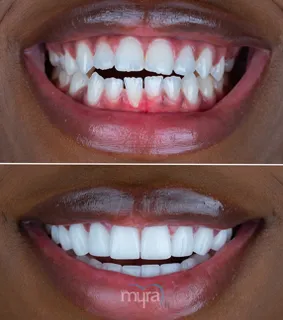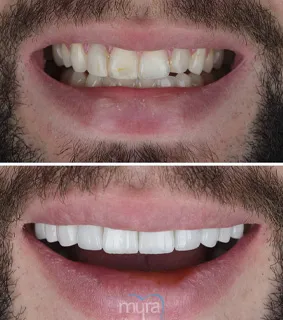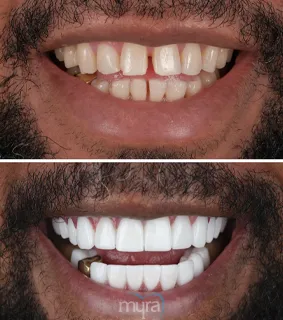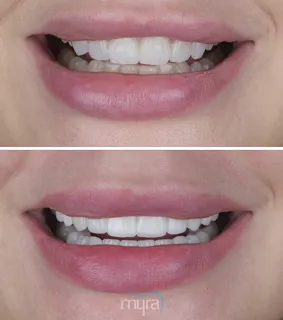A sinus lift is a dental surgical technique that includes grafting more bone onto the upper jaw above the molars and premolars. When there is insufficient jawbone in the upper jaw, such a procedure is often necessary to secure dental implants.
During a sinus lift, a small incision is made in the gums to reveal the jawbone underneath. The membrane lining the sinus cavity is gently pulled upward after the bone is drilled to make room for the graft. Following the placement of the bone graft material, the incision is closed using stitches.
Bone grafts are created using either the patient's tissue (often removed from the hip or jawbone) or a synthetic substance. Antibiotics and painkillers are usually prescribed after the treatment, and the patient is typically told to refrain from blowing their nose, sneezing, or using a straw for a few days.
Several factors, like the degree of difficulty involved, the quantity of bone graft material required, and the proximity of the dental office to the patient's home, affect how much a sinus lift ought to set someone back. The average cost per sinus ranges from £1,200 to £4,000.
Individual patients and the complexity of their sinus lift procedures determine how long they need to recuperate. Swelling, bruising, and soreness are all possible side effects of any medical operation. The dentist often recommends a period of rest during which patients are advised to avoid specific foods and activities depending on the procedure. Most patients are able to return to work and normal activities within a week to 10 days after the procedure.
What is Sinus Lift?
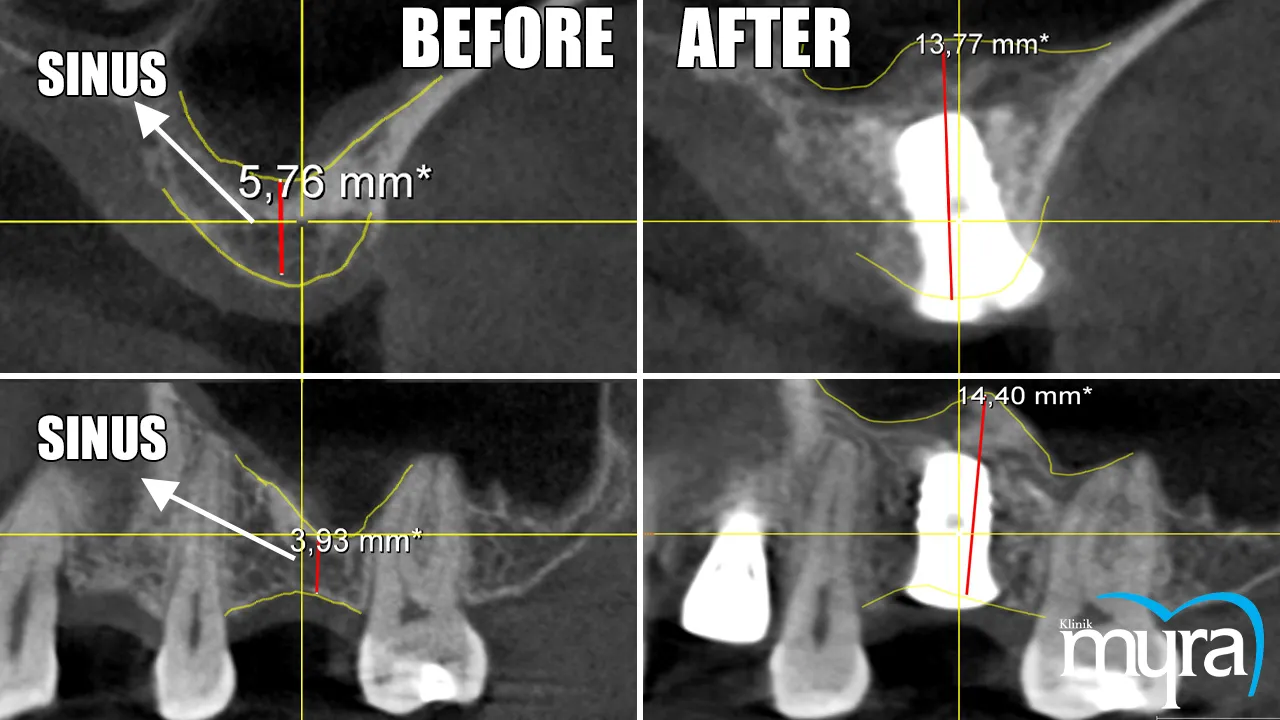
A sinus lift is a dental procedure often performed in preparation for dental implants. It is a surgical procedure that involves adding bone to the upper jaw in the area of the molars and premolars. The purpose of a sinus lift is to increase the amount of bone in the upper jaw, creating a stable foundation for dental implants.
The bone that once supported them starts to deteriorate when teeth are lost in the upper jaw leading to a reduction in bone height and density, which makes it difficult to place dental implants securely. The maxillary sinus is located above the upper jaw and sometimes expands into the space where the upper teeth used to be, hence, the amount of bone available for dental placement is reduced.
A sinus lift surgery is typically performed when there is not enough bone in the upper jaw to support dental implants.Bone graft material is added to the upper jaw to create a stable foundation for the implants. A bone graft is often taken from the patient’s own body or synthetically made. A sinus lift procedure is vital in ensuring the stability of the implants compared to other dental implant techniques.
Increasing the amount of bone in the upper jaw during a sinus lift procedure helps ensure that dental implants are placed securely and are able to withstand the pressure of chewing and biting. Sinus lift improves the long-term success rate of dental implants and helps restore the patient’s ability to eat, speak, and smile confidently.
When is a Sinus Lift needed?
Sinus lift is typically required when there is insufficient bone in the upper jaw to accommodate dental implants. There are numerous reasons why sinus lift surgery is required for specific dental procedures. The bone that supports them begins to degrade and be reabsorbed by the body when the upper jaw teeth are gone. Over time, the bone mass is reduced, changing the face structure and producing a sunken or aged appearance that makes it difficult to secure dental implants.
Periodontal Gum Disease is a chronic bacterial infection that affects the gums and bones that support the teeth. It is caused by the accumulation of plaque and bacteria on the teeth and gums, which leads to inflammation and tissue damage. Infection spreads to the bone and other supporting tissues and reduces the quantity of bone accessible for dental implant insertion. Additionally, trauma or developmental problems and maxillary sinus enlargement lead to a lack of bones in the upper jaw, necessitating sinus lift surgery.
A dental implant expert or an oral surgeon assesses the patient's bone structure and dental health to determine if a sinus lift is necessary. For instance, a CT scan is used to determine the quantity of accessible bone.
There is evidence that sinus lift treatments successfully augment the amount of bone in the upper jaw and provide a secure base for dental implants.94.3% of patients who underwent sinus lift surgery had a success rate for dental implants for 10 years, as shown in a study published in the Journal of Clinical Periodontology. The use of bone graft material in sinus lift surgeries resulted in substantial increases in the upper jaw's bone density.
What are the procedures before a Sinus Lift?
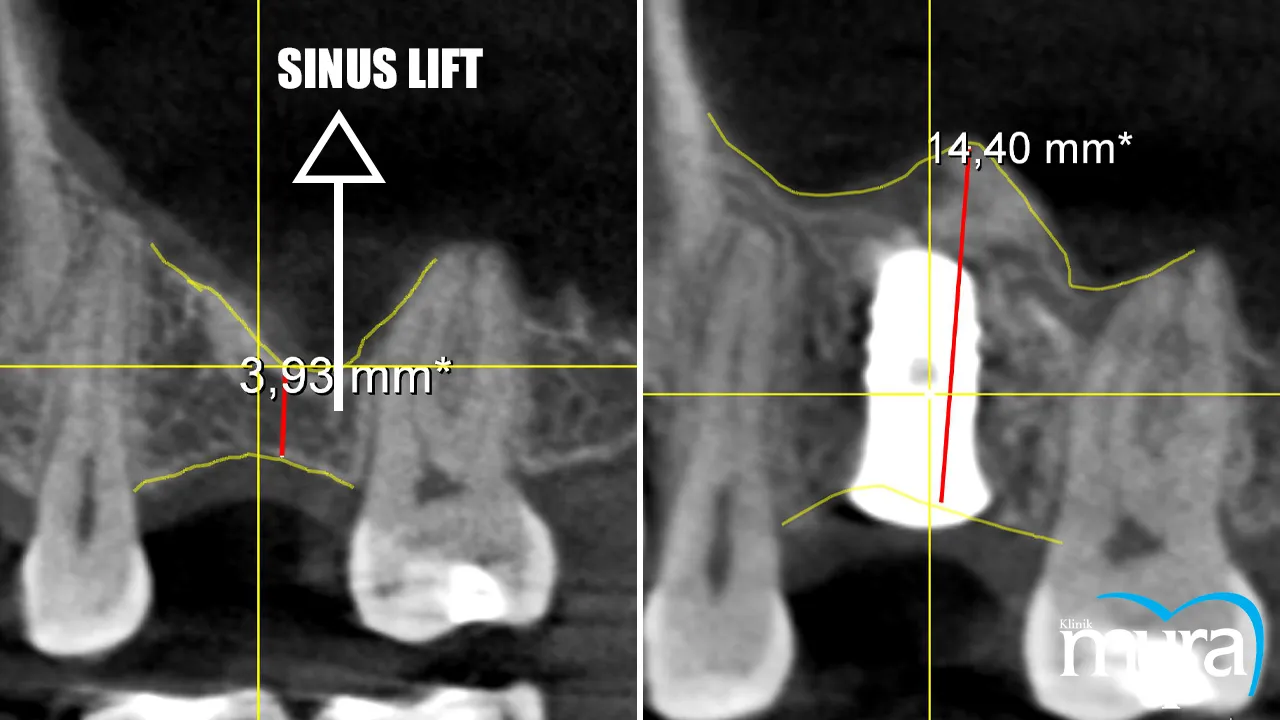
Listed below are the procedures before a Sinus Lift:
- Dental Exam. The purpose of the dental exam is to assess the patient's oral health and the extent of tooth loss or damage.
- X-rays. The amount of bone in the upper jaw and the position of the sinus cavity is evaluated using radiographic techniques.
- Cone Beam Computed Tomography (CBCT). CBCT is a type of 3D imaging that delivers detailed information regarding the upper jaw's b one structure and sinus cavity.
- Medical History Review. The surgeon checks the patient's medical history to verify that the patient is healthy enough to undertake the treatment .
- Medication Review. The surgeon verifies that the patient is not taking any medications that interfere with the surgery or recuperation.
- Treatment Plan. The surgeon creates a treatment plan that includes sinus lift surgery, dental implants, or other operations based on the results of the dental exam, x-rays, and CBCT.
- Anaesthesia. Anaesthesia is administered to the patient prior to beginning the sinus lift procedure. It includes the use of local anaesthetic or conscious sedation to assist the patient in relaxing and feeling comfortable during surgery.
- Incision. After administering anaesthesia to the patient, the surgeon makes an incision in the gum tissue near the back of the upper jaw to reveal the underlying tissue.
- Accessing the sinus. The surgeon creates a small incision in the bone to separate the sinus chamber from the jawbone in order to gain access to the sinus membrane.
- Lifting the sinus membrane. The surgeon presses the sinus membrane gently upward and away from the jawbone to create space for the bone graft material.
- Bone graft placement. The graft material is then inserted between the sinus membrane and the jawbone. Bone transplant material is either harvested from the patient, a donor, or synthetic material.
- Closing the incision. The surgeon closes the incision with stitches after successfully placing the bone graft material. Gauze is applied to the affected region to reduce bleeding and aid healing.
- Infection: Infection is a possibility following any surgical procedure. Patients are therefore provided antibiotics to prevent infection.
- Bleeding: Bleeding is a common concern following surgery; therefore, patients are urged to adhere to the surgeon's postoperative instructions in order to limit bleeding.
- Pain and swelling: Pain medications provided by the surgeon and over-the-counter pain relievers aid in the management of pain and swelling symptoms.
- Sinus problems: Sinus lift surgery, as its name suggests, includes operating around the sinus cavity. Patients undergoing sinus surgery sometimes encounter congestion, pressure, or sinus infections.
- Nerve damage: The procedure causes nerve injury in the region, resulting in numbness or tingling in the face or lips.
- Bone graft failure: Infrequently, the bone transplant material fails to merge with the surrounding bone tissue, necessitating further surgery.
- Implant failure: There is a possibility that the dental implant implanted during sinus lift surgery refuses to integrate with the bone, necessitating additional surgery.
Before the procedure, it is essential that the patient share any concerns or questions with the surgeon to ensure that they are well-informed and comfortable with the treatment plan.
How is Sinus Lift Surgery Done?
Listed below are the six steps on how Sinus Lift Surgery is done.
Following the operation, the patient is given post-operative care instructions, including drugs to treat pain and swelling and feeding and drinking recommendations. Patients are urged not to blow their noses during their healing period. The recovery period for sinus lift surgery varies, but the majority of patients are able to return to work and normal activities within a few days to a week. It is essential to adhere to the surgeon's aftercare instructions to guarantee optimal healing and reduce the chance of problems.
Can Sinus Lift Surgery cause Sinus Problems?
Yes, sinus lift surgery is generally a safe and successful technique with a low incidence of complications. There is a possibility of adverse effects and complications. The emergence of sinus issues is a potential consequence of sinus lift surgery.
The surgeon lifts the sinus membrane and inserts bone graft material into the area between the membrane and the jawbone during the surgery which causes swelling and inflammation in the sinus cavity and, in some people, sinus issues.
Patients who experience sinus issues after sinus lift surgery must contact their surgeon immediately. The surgeon suggests over-the-counter or prescription drugs, such as decongestants or antibiotics, to address the symptoms.
It is crucial for patients to adhere to their surgeon's post-operative recommendations precisely to reduce the risk of sinus complications following sinus lift surgery. It includes refraining from blowing the nose or using a straw for a period of time following surgery, taking prescription medications as indicated, and attending follow-up meetings with the surgeon to evaluate healing. Sinus difficulties following sinus lift surgery are uncommon, and the majority of patients recover without complications.
How much does a Sinus Lift Surgery Cost?
The cost of sinus lift surgery varies greatly based on a number of factors, including the geographic location of the surgery, the experience and expertise of the surgeon, the type of anaesthesia used, the cost of the bone graft material, and any costs associated with preoperative exams and postoperative care.
The average cost per sinus ranges from £ 200 to £4,000, excluding the cost of dental implants or other essential treatments. Rates are greater in urban and high-cost-of-living locations, and general anaesthesia is often more expensive than local anaesthetic.
Moreover, the cost of the bone graft during surgery varies substantially according to the material chosen. Some surgeons even charge extra fees for preoperative exams and postoperative care. The type of sinus lift surgery, whether lateral or crestal affects the overall cost as well. Lateral sinus lift surgery is a more invasive procedure and is more expensive than a crestal sinus lift. The total expenses for the operation is increased for surgeries that are considered to be more complex and take longer especially if the patient has significant bone loss or other oral health issues.
Hence, it is essential for patients to discuss the cost of a sinus lift with their physician before the treatment. Some insurance policies pay a portion of the cost of surgery, which patients have to inquire about to help offset the expense of the procedure.
How long does it take to Recover from Sinus Lift Surgery?
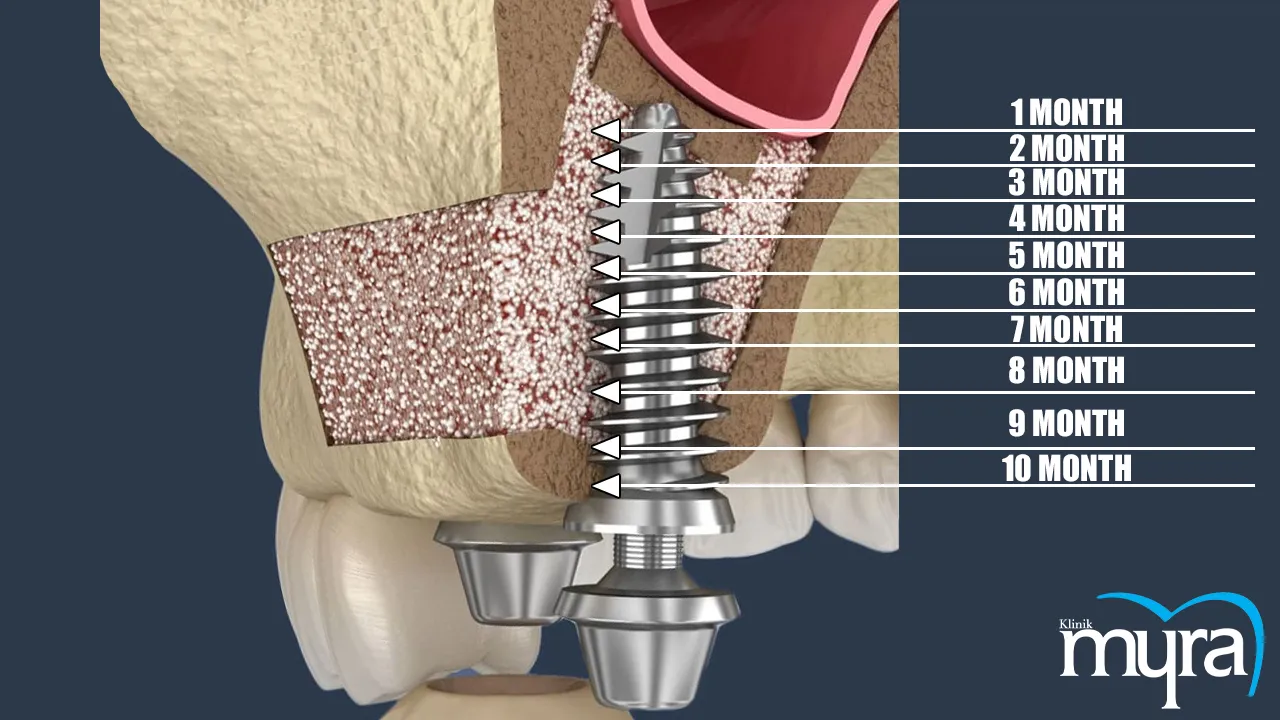
Recovery time following sinus lift surgery varies based on a number of factors, including the length of the surgery, the patient's overall health, and how well the patient follows postoperative instructions.
The patient is expected to experience discomfort, oedema, and bleeding in the area following surgery. Antibiotics or prescription painkillers are useful for treating symptoms and preventing infection. Applying an ice pack to the affected area is effective for reducing swelling. The patient is advised to rest as much as possible and avoid severe physical activity or exercise during the first few days following surgery. Smoking and the use of tobacco products are to be avoided, as they impede the healing process.
The patient is instructed to return to the surgeon's office for a follow-up appointment within a week or two following surgery. The surgeon assesses the healing progress and removes any sutures inserted after surgery. The majority of patients are able to resume regular daily activities within a week or two, although it takes many months for the bone graft material to integrate completely with the surrounding tissue. Therefore, the patient is instructed to avoid exerting any pressure on the area and to consume only soft foods to avoid compromising the dental implant recovery.
The recovery period for sinus lift surgery depends on the degree of the surgery and the patient’s overall condition which usually ranges from a few days to several months. It is essential to carefully adhere to the surgeon's postoperative recommendations to guarantee appropriate healing and reduce the chance of problems. The patient is required to attend all follow-up appointments to monitor the healing process and address any concerns or issues.
What are the possible side effects of Sinus Lift Surgery?Graft Failure
Graft failure refers to the condition where the bone graft material used in a surgical procedure fails to integrate properly with the surrounding bone. This can result in implant loosening or failure. Preventive measures include selecting an experienced dental professional and ensuring proper patient selection. Treatment involves prompt intervention to prevent further complications and restore function. Long-term implications include the need for additional surgeries and compromised oral health.
Sinusitis
Sinusitis is the inflammation or swelling of the tissue lining the sinuses, leading to discomfort, headache, congestion, and nasal discharge. Preventive measures include good hygiene practices and managing allergies. Treatment options depend on the underlying cause and may involve antibiotics, decongestants, nasal irrigation, and pain relievers. Long-term implications include chronic sinusitis, nasal polyps, and potential spread to surrounding areas.
Perforation of the Sinus Membrane
Perforation of the sinus membrane can occur during sinus lift surgery, where the sinus membrane is accidentally punctured or damaged. Preventive measures include thorough preoperative evaluation, meticulous surgical technique, and using high-quality bone graft material. Treatment involves immediate repair of the perforation using various techniques. Long-term implications include infection, implant failure, and the need for additional surgeries.
Gum Swelling or Bleeding
Gum swelling and bleeding can occur as a result of trauma during dental procedures or as part of the healing process. Good oral hygiene and regular dental checkups help prevent these issues. Prompt treatment involves maintaining oral hygiene, following post-operative instructions, and seeking dental care if needed. Long-term implications include gum disease, tooth loss, and potential systemic health complications.
Delayed Healing
Delayed healing refers to a slower-than-normal healing process following dental procedures, which can increase the risk of infection and prolonged pain. Preventive measures include good oral hygiene, managing underlying medical conditions, avoiding tobacco use, and following post-operative instructions. Treatment may involve increasing oral hygiene practices, antibiotics, and additional surgical procedures. Long-term implications include infection, implant failure, and prolonged healing times.
Difficulty Chewing
Difficulty chewing can occur after sinus lift surgery due to swelling and discomfort in the area. Maintaining good oral hygiene and modifying the diet to include soft foods are recommended preventive measures. Treatment involves pain management and addressing any underlying issues causing the discomfort. Long-term implications include digestive issues, malnutrition, and potential dental complications.
Infection
Infection can occur following dental procedures, particularly sinus lift surgery. Preventive measures include avoiding smoking, maintaining good oral hygiene, and attending follow-up appointments. Treatment may involve antibiotics, pain management, and drainage of abscesses. Untreated infections can have long-term implications on oral health and overall well-being, spreading to other areas of the mouth or body.
What are the Potential Risks of the Sinus Lift Surgery?
Listed below are the potential risks of the Sinus Lift Surgery.
It is essential for patients to discuss the potential risks and problems with their surgeon before undergoing sinus lift surgery. Patients are required to strictly adhere to all preoperative and postoperative recommendations in order to reduce the risk of problems and promote normal recovery.
When should you consult a doctor after Sinus Lift Surgery?
Patients undergoing sinus lift surgery ought to keep careful tabs on their progress in the days and weeks following the procedure and adhere strictly to their dentist's post-operative care guidelines. When the following occur after surgery: excessive bleeding that does not stop with gentle pressure; severe pain or swelling that does not improve with medication or worsens over time; a temperature of 101 degrees Fahrenheit or higher with chills; trouble breathing; pus or discharge from the surgical site; or the implant feels loose or moves excessively, medical attention has to be sought immediately. Patients experiencing any of these symptoms have to see a doctor right away to reduce the risk of complications and speed up their recovery. Individuals undergoing sinus lift surgery must be aware of these potential problems and seek medical attention if they develop any worrying symptoms.
Are there failed cases of Sinus Lift Surgeries?
Yes, there are failed cases of sinus lift surgeries. Sinus lift surgery has a very high success rate, although it does not work in some cases. The procedure has a high success rate, but there are always dangers and complications that cause it to fail. Inadequate bone volume is a common cause of implant failure. It occurs either because the bone graft material used during surgery did not successfully integrate with the surrounding bone or because the implant itself was not adequately supported by the bone. Other causes of the insufficient bone volume include incorrect implant placement and surgical trauma.
The failure of the graft itself is another possible cause of failure. Implant failure occurs if the bone graft material in sinus lift surgery does not effectively merge with the surrounding bone. Lack of blood flow, faulty graft preparation or placement, or immune system rejection are all potential causes of graft failure.
Another risk factor for implant failure following sinus lift surgery is infection. Infections delay healing and cause implant failure. It proves to be fatal if the infection spreads to the body and causes sepsis if not treated immediately. Moreover, failure of an implant often happens when there are sinus problems. Perforation of the sinus membrane or injury to the surrounding sinus tissues during surgery increases the risk of complications and implant failure. Too much implant length or penetration into the sinus cavity potentially leads to difficulties.
Is Sinus Lift a critical surgery?
Yes, Sinus Lift is a critical surgery. The level of criticality of sinus lift surgery depends on several factors, such as the individual’s overall health, the severity of the bone loss in the upper jaw, and the complexity of the surgery. Sinus lift surgery is generally considered a safe and effective procedure. It is relatively critical in certain cases, such as in individuals with compromised immune systems, uncontrolled diabetes, or other underlying medical conditions that increase the risk of complications.
It is important to note that sinus lift surgery is a specialised procedure that requires a high level of skill and experience on the part of the dental professional performing the surgery. Choosing a qualified and experienced dental professional is critical in ensuring a safe and successful outcome.
Is it normal to experience headaches after a Sinus Lift Surgery?
Yes, headaches are a common side effect after sinus lift surgery. Many different things, like inflammation, oedema, altered blood flow, or pressure changes in the sinuses, contribute to the onset of a headache. Inflammation and oedema are common side effects of the body’s natural healing process following sinus lift surgery. Pressure on nerves and blood vessels due oedema and inflammation results in headaches.
Changes in blood flow potentially lead to headaches after sinus lift surgery. Headaches are a common side effect of surgery because blood flow to the head and face is altered during the procedure. Sinus pressure alterations raise the sinus membrane to make room for the bone transplant material. Those prone to sinus or migraine headaches are bound to feel additional pain from these pressure shifts.
Keep in mind that although headaches are typical, it is crucial to keep an eye on them and let the doctor know if they seem severe. An infection or nerve damage are two of the rarer complications that cause headaches after sinus lift surgery.
Is Sinus Lift Surgery a Dental Treatment Implant?
Yes. Sinus lift surgery is a dental treatment often performed to provide sufficient bone support for dental implant placement in the upper jaw. The sinus membrane is lifted to create space for bone graft material to be placed in the area where the dental implant is inserted. The bone graft material stimulates the growth of new bone, creating a stronger and more stable base for the implant. The dental treatment implant is performed once the bone graft has healed and integrated with the surrounding bone. Hence, sinus lift surgery must be performed first, making it an important part of the implant process.
What is the difference between Sinus Lift Surgery and Bone Grafting?
Sinus lift surgery is performed to provide sufficient bone support for dental implants in the upper jaw. It aims to enhance the success and longevity of dental implants by augmenting the bone in the region of the upper molars and premolars. The technique involves creating a small aperture in the lateral wall of the maxillary sinus to access the sinus membrane. After exposing the membrane, it is carefully lifted and separated from the underlying bone, making space for the bone graft material. The most common location for sinus lift surgery is the posterior upper jaw, where the bone is thinnest and prone to loss. The procedure typically takes 60-90 minutes, and a healing period of 6-9 months is required for proper integration of the bone graft. The success rate of sinus lift surgery ranges from 85% to 95%, depending on various factors such as bone loss extent, graft material, patient's health, and the expertise of the dental professional.
Bone grafting is performed to replace or augment lost or injured bone. It involves transplanting bone tissue from one part of the body to another where new bone growth is needed. Autograft, allograft, and alloplastic graft are commonly used techniques. Autograft involves using the patient's own bone tissue, usually from the pelvis or jaw. Allograft utilizes bone tissue from a donor, with living cells removed. Alloplastic grafts use synthetic materials that mimic natural bone. The location of bone grafting depends on the individual's needs, with the jawbone being a common site for dental implant support. The timeframe for bone grafting varies, but it generally involves several months for proper integration and healing. The success rate of bone grafting depends on factors like overall health, extent of bone loss, graft material used, and the skill of the dental or medical professional. Complications such as infection, graft failure, or rejection of the graft material are rare but can impact the success rate. Proper planning, execution, and post-operative management help ensure a successful outcome for bone grafting procedures.






